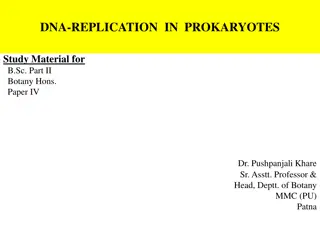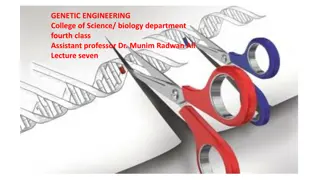Understanding DNA Structure: A Comprehensive Overview
DNA, or deoxyribonucleic acid, is a fundamental molecule in genetics. It consists of two antiparallel polynucleotide chains made up of monomer units containing sugars, phosphates, and nitrogenous bases. The structure of DNA includes deoxyribose sugar, phosphate groups, and nitrogenous bases like adenine, guanine, cytosine, and thymine. Hydrogen bonds between base pairs stabilize the double helical structure of DNA. Optically, DNA absorbs light at 260nm due to its nitrogenous bases. This summary provides a detailed insight into the molecular composition and characteristics of DNA.
Download Presentation

Please find below an Image/Link to download the presentation.
The content on the website is provided AS IS for your information and personal use only. It may not be sold, licensed, or shared on other websites without obtaining consent from the author. Download presentation by click this link. If you encounter any issues during the download, it is possible that the publisher has removed the file from their server.
E N D
Presentation Transcript
SPECTRAL SPECTRAL CHARACTERIZATION CHARACTERIZATION OF OF DNA DNA Sarah AlDosari
DNA DEOXY RIBONUCLEIC ACID
DEOXY RIBONUCLEIC ACID (DNA) DNA is made of 2 polynucleotide chains which run in opposite direction. antiparallel DNA has a double helical structure. Each polynucleotide chain of DNA consists of monomer units. A monomer unit consists of 3 main components that are: 1. A sugar, 2. a phosphate, 3. a nitrogenous base.
NUCLEOTIDE Monomer
DNA STRUCTURE 1. Deoxyribose sugar: Is a monosaccharide 5-Carbon Sugar, Its name indicates that it is a deoxy sugar, meaning that [ it is derived from the sugar ribose by loss of an oxygen atom ]. 2. Phosphate Group: The sugars are joined together by phosphate groups that form phosphodiester bonds between the third and fifth carbon atoms of adjacent sugar rings.
DNA STRUCTURE 3. Nitrogenous bases: is a nitrogen-containing organic molecule having the chemical properties of a base They are classified as the derivatives of two parent compounds, 1. Purine. [ Adenine, Guanine ] 2. Pyrimidine. [ Cytosine, Thymine ]
DNA STRUCTURE 4. Hydrogen bond: The H-bonds form between base pairs of the antiparallel strands. The base in the first strand forms an H-bond only with a complementary base in the second strand. Those two bases form a base-pair (H-bond interaction that keeps strands together and form double helical structure).
DNA STRUCTURE The hydrophobic bases are inside the double helix of DNA, give the hydrophobic effect to stabilizes the double helix. while sugars and phosphates are located outside of the double helical structure.
OPTICAL DENSITY OF DNA Nucleic acid would be expected to have maximum absorbance at 260. It absorbs at this wavelength because of the nitrogenous bases (A, G, C and T) of DNA. Absorbance In a spectrophotometer, a sample is exposed to ultraviolet light at 260 nm, and a photo- detector measures the light that passes through the sample. Wave length (nm)
HYPERCHROMICITY The increase of absorbance (optical density) of a material. The most famous example is the hyperchromicity of DNA that occurs when the DNA duplex is denatured. Absorbance The opposite, a decrease of absorbance is called hypochromicity. Wave length (nm)
DENATURATION OF DNA Many different substances or environmental conditions can denature DNA, such as: strong acids, organic solvent heating
EXPERIMENT OF DAY SPECTRAL CHARACTERIZATION OF YEAST DNA Objective: To establish the wave length that represent the maximum absorbance for DNA. To establish the hyperchromic effect on DNA. Principle: The double helix of DNA are bound together mainly by hydrogen bonds and hydrophobic effect between the complementary bases. . When DNA in solution is heated above its melting temperature (usually more than 80 C), the double- stranded DNA unwinds to form single-stranded DNA.
EXPERIMENT OF DAY SPECTRAL CHARACTERIZATION OF YEAST DNA Principle: In single stranded DNA the bases become unstacked and can thus absorb more light. In their native state, the bases of DNA absorb light in the 260-nm wavelength region. When the bases become unstacked, the wavelength of maximum absorbance does not change, but the amount absorbed increases by 30-40%. a double strand DNA dissociating to single strands produces a sharp cooperative transition.
EXPERIMENT OF DAY SPECTRAL CHARACTERIZATION OF YEAST DNA Materials: DNA concentrated sample( extracted from yeast). 1X saline solution ( NaCl with Tri Sodium Citrate). Quartz Cuvtte. Spectrophotometer.
EXPERIMENT OF DAY SPECTRAL CHARACTERIZATION OF YEAST DNA Method: Set and lable 6 test tube : D1, D2, D3,D4,D5,D6 1. In D1 pipette 0.5 ml of isolated DNA (extracted from Yeast) and add to it 4.5ml of 1X saline-citrate. Mix it very will. Measure the absorbance of D1 at 260nm if it is > 3 : 2. In D2 pipette 0.5 ml of D1 ,add to it 4.5ml of 1X saline-citrate. Mix it very will. Measure the absorbance of D2 (if the absorbance is greater than 1,dilute the solution until you obtain A260 of 1 or slightly less).
EXPERIMENT OF DAY SPECTRAL CHARACTERIZATION OF YEAST DNA Method: When the absorbance of solution (A260 1.0) is obtained read the absorbance of the solution at the following wave lengths: (240,245,250,255,260,265,270,275,280) using 1X saline as a blank.
EXPERIMENT OF DAY SPECTRAL CHARACTERIZATION OF YEAST DNA Method: Now take the dilution tube which give an absorbance=1 ,cover the tube and put it in boiling water bath for 15 min Immediately measure the absorbance at the following wave lengths: (240,245,250,255,260,265,270,275,280) using 1X saline as a blank.
EXPERIMENT OF DAY SPECTRAL CHARACTERIZATION OF YEAST DNA Results: Wave length (nm) Absorbance of isolated DNA Absorbance of heated DNA Plot The absorption spectra of the native DNA solution and the denatured DNA against wave lengths. 240 245 250 Record Your result and write your comment in the discussion. 255 260 265 270 275 280























